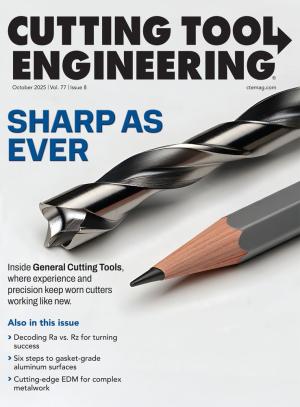
Only 12 more months until the 36th International Manufacturing Technology Show. For those of you unfamiliar with the show, it is the largest manufacturing show in the Western Hemisphere. Machine tool builders, cutting tool makers and others often use IMTS as a venue to launch new products and innovative technologies.
I have been fortunate enough to attend IMTS several times since my first visit in 1996. Over these last 30 years I have watched the show change. In the 1990s there was an emphasis on machine tool advancement. We were presented with innovations like faster controls, improved machine dynamics, high pressure coolant delivery and advanced spindle geometries.
In the early 2000s the emphasis shifted to improved cutting tools and advanced CAM software that allowed shops to fully utilize the faster controls and highly dynamic machine tools.
Last year’s show was different. I did not see any noticeable advancements in machine tool technology or cutting tool technology. There were new products, of course, but nothing that really grabbed my attention.
The show was dominated by devices that improved the way humans interact with machines and processes. Collaborative robots, connectivity devices and ergonomic products were the highlights in almost every booth I visited. It was obvious that companies are seeking productivity gains in different ways than they were just a few years ago.
In the past we looked for faster machines and better cutting tools to improve productivity. Today we are looking for ways to improve the human experience while reducing human intervention in the manufacturing process. We desire to create manufacturing environments that are safer, cleaner and utilize the same technology we use in our personal lives. Manufacturers are looking for ways to improve the human experience in manufacturing spaces.
Enter design technology
Design technology (DT) is a concept, and in some cases a curriculum, that provides innovative ideas for achieving productivity improvements by emphasizing a holistic approach to product and process design. DT constructs promote the integration of technology, advanced engineering tools and traditional manufacturing concepts as a way to improve the human experience in manufacturing spaces. By integrating existing tools and emphasizing human experience manufacturers can expect to see improved productivity.
DT intersects with other theories and ideas like IoT or the internet of things. IoT is the term used to describe the interconnectedness of devices, machines and networks so that there is a seamless flow of data throughout the system. IoT provides the connectivity needed for humans to experience the manufacturing space in the same way they experience their personal space. Mobile devices, short video formats and “swiping” are becoming more common in modern manufacturing and making the manufacturing space more comfortable. IoT is a foundational element in DT constructs.
Design for Manufacturing and Design for Assembly (aka DFM and DFA) are sometimes used synonymously with DT. Yet, DFM and DFA are actually foundational elements to DT. We often joke about the engineers adding seemingly silly features to parts that frustrate tool makers and machinists, but unnecessary features or overly restrictive tolerances are nothing to laugh about when they negatively impact the way humans experience the manufacturing space. DFM and DFA are concepts that place an emphasis on creating features and geometries that are manufacturing friendly. When properly applied, DFM and DFA improve the human experience inside manufacturing spaces.
Lean manufacturing and associated tools are also elements of design technology that focus on the reduction of waste in the manufacturing processes while focusing on the human element of manufacturing. Lean manufacturing often utilizes technology to improve ergonomics, manufacturing spaces and the interface between humans and machines. However, lean manufacturing does not specifically seek to integrate technology into manufacturing. With DT there is an emphasis on the utilization of modern tech to enhance the tools promoted by lean manufacturing.
DT purposely seeks to integrate technology into the manufacturing and design space. Because of this CAD/CAM, virtual manufacturing, rapid prototyping and similar tools are critical to designing more efficient manufacturing processes. By integrating technology with the elements mentioned earlier, design and manufacturing engineers are able find and fix defects in the digital realm. Identifying problems in the digital realm accelerates the iterative design process, which results in improved quality, reduced costs and provides a competitive edge in the market. Most importantly, iterating in the digital realm allows designers tremendous latitude to investigate and test ideas that improve products and processes, and thereby improve the human experience.
As we move into the future, productivity improvements are going to be driven by improving the human experience inside of the manufacturing space. Improved experiences will require multifaceted solutions that integrate technology, engineering and traditional manufacturing methodology. Design technology constructs provide the foundation for the integration of these tools.
Related Glossary Terms
- computer-aided manufacturing ( CAM)
computer-aided manufacturing ( CAM)
Use of computers to control machining and manufacturing processes.
- coolant
coolant
Fluid that reduces temperature buildup at the tool/workpiece interface during machining. Normally takes the form of a liquid such as soluble or chemical mixtures (semisynthetic, synthetic) but can be pressurized air or other gas. Because of water’s ability to absorb great quantities of heat, it is widely used as a coolant and vehicle for various cutting compounds, with the water-to-compound ratio varying with the machining task. See cutting fluid; semisynthetic cutting fluid; soluble-oil cutting fluid; synthetic cutting fluid.
- lean manufacturing
lean manufacturing
Companywide culture of continuous improvement, waste reduction and minimal inventory as practiced by individuals in every aspect of the business.

